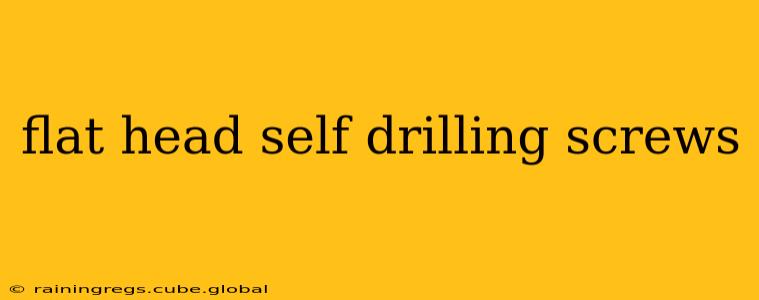Flat head self-drilling screws are a versatile and efficient fastening solution for various applications. Their unique design combines drilling and screwing in a single operation, eliminating the need for pre-drilling and significantly speeding up the installation process. This guide will delve into the specifics of these screws, exploring their benefits, applications, and considerations for optimal usage.
What are Flat Head Self Drilling Screws?
Flat head self-drilling screws are designed with a sharp, pointed tip that acts as a drill bit. This allows the screw to penetrate various materials, including metal, wood, and plastic, without the need for pre-drilling. The flat head design sits flush against the surface, providing a clean and aesthetically pleasing finish. This contrasts with other self-tapping screw head types, such as pan head or oval head self-drilling screws.
What are the Benefits of Using Flat Head Self Drilling Screws?
The primary advantage of using flat head self-drilling screws is their speed and efficiency. They significantly reduce installation time by eliminating the pre-drilling step. This translates to cost savings, especially in large-scale projects. Other key benefits include:
- Versatility: They can be used on a wide range of materials.
- Strength: They offer a strong and secure fastening solution.
- Clean Finish: The flat head provides a neat, professional appearance.
- Reduced Tool Requirement: You only need a screwdriver or drill driver, unlike with traditional screws which often need a separate drill bit.
What Materials are Flat Head Self Drilling Screws Used For?
Flat head self-drilling screws are used extensively across numerous industries. Common applications include:
- Metal Fabrication: Joining sheet metal, steel, and aluminum components.
- Construction: Fastening wood to metal framing, attaching siding, or securing roofing elements.
- Automotive: Securing parts and components in vehicle manufacturing.
- Electrical Work: Mounting electrical boxes and other components.
- HVAC Applications: Attaching ductwork and other components in heating, ventilation, and air conditioning systems.
What are the Different Types of Flat Head Self Drilling Screws?
Several variations of flat head self-drilling screws exist, catering to specific material types and applications. These variations often differ in:
- Material: Common materials include steel, stainless steel, and zinc-plated steel. The choice depends on the application's environmental requirements (e.g., corrosion resistance).
- Thread Type: The thread design affects the screw's holding power and penetration capabilities. Different thread pitches and forms are available for optimal performance in various materials.
- Point Type: Variations in the point type (e.g., type 17, type 25) allow for optimized drilling performance and suitability for specific material thicknesses.
How to Choose the Right Flat Head Self Drilling Screw?
Selecting the appropriate flat head self-drilling screw requires careful consideration of several factors:
- Material being fastened: The screw material and thread type must be compatible with the material you're working with. Steel screws are suitable for most applications, but stainless steel provides superior corrosion resistance.
- Thickness of the material: The screw's length and point type should be selected based on the material thickness. Using a screw that's too short or too long can compromise the fastening strength or damage the material.
- Desired holding power: Different thread designs and materials offer varying levels of holding power. Choose a screw that provides adequate strength for the specific application.
- Head Size and Type: Confirm that the flat head will sit flush and provide the desired aesthetic.
What are the Applications for Flat Head Self Drilling Screws in Construction?
In the construction industry, flat head self-drilling screws find numerous applications:
- Metal Roofing: Securing roofing panels to metal framing.
- Siding Installation: Attaching metal or composite siding to structural supports.
- Decking: Joining metal or composite decking boards.
- HVAC Systems: Securing ductwork and other components.
Are Self-Drilling Screws Stronger Than Regular Screws?
The strength of a self-drilling screw compared to a regular screw depends heavily on the application. In many scenarios, especially when dealing with thinner materials, a self-drilling screw's ability to create its own pilot hole can actually improve overall strength by preventing material splitting or cracking, which is something that can happen when using a standard screw on thinner metal. However, for very thick materials, a predrilled hole and a regular screw might provide a stronger hold.
What is the Difference Between Self-Tapping and Self-Drilling Screws?
While both self-tapping and self-drilling screws can fasten into materials without pre-drilling, there's a key distinction. Self-tapping screws form threads in the material as they're driven in, requiring a pilot hole in most cases; while self-drilling screws have a drill point on the tip, making their own hole as they drive and thus generally eliminating the need for pre-drilling.
This comprehensive guide provides a solid foundation for understanding and utilizing flat head self-drilling screws effectively. Remember to always consult manufacturer specifications for specific application guidance and safety precautions.
